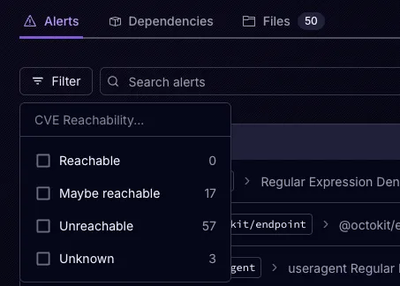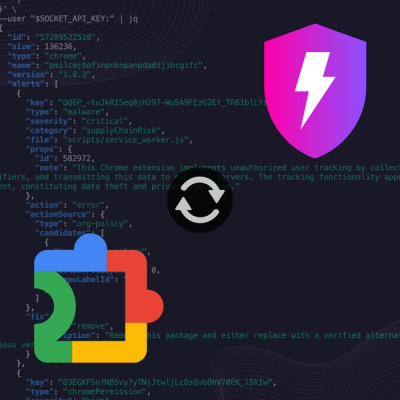
Product
Announcing Precomputed Reachability Analysis in Socket
Socket’s precomputed reachability slashes false positives by flagging up to 80% of vulnerabilities as irrelevant, with no setup and instant results.
Introduction | Create Menu with a module | Create Menu within a Notebook | Installation | Change Log | License
This package contains utilities for building hierarchical menus that appear in the Jupyter notebook menu bar. Unlike extensions, these menus can be added using python import statements, so only appear in notebooks where the module(s) that creates them are imported.
The expectation is that JPSLMenus will be imported into the notebook by other modules when they are imported so that each module can use these javascript menu creation tools to construct their own menus. It is also possible to create a menu on-the-fly from javascript in a code cell (see below).
(NOTE: below may need modifying to work with a slow connection. Maybe use
promise to wait until the object JPSLMenus is defined?)
JPSLMenus.build(menu):
var item = {'type':'url|action|snippet|computedsnippet|submenu|menu',
'title':'String that will appear in menu',
'data': \\depends on type
\\ url: "string url"
\\ action: "single line of valid javascript"
\\ snippet: ["code line 1","code line 2"...]
\\ computedsnippet: "single line of valid javascript"
\\ that returns a string representation of the
\\ snippet to insert.
\\ submenu: [item1, item2...] items can be submenus.
\\ menu: [item1, item2...] items can be submenus.
};
let NameOfYourModule = new Object();
NameOfYourModule.createMenu = function(){
var aurl={'type':'url',
'title':'Lewis Structure Tutorial',
'data':'https://cms.gutow.uwosh.edu/Gutow/tutorials/lewis-structure-tutorial'
};
var anaction ={'type':'action',
'title':'Flag selected cells in pink',
'data':"var celllist = Jupyter.notebook.get_selected_cells();for (var i = 0;i<celllist.length;i++){celllist[i].element.children()[0].setAttribute(\"style\",\"background-color:pink;\");}"
};
var asnippet = {'type':'snippet',
'title':'Python snippet',
//Use double quotes around each line of code.
'data':["# A comment","print('Hello World!')"]
};
var acompsnippet = {'type':'computedsnippet',
'title':'Computed snippet',
//Use double quotes around the line of valid javascript.
'data':"'# The time is '+Date()"
};
var asubmenu = {'type':'submenu',
'title': 'SubMenu',
'data':[aurl, anaction]
};
var menu = {'type':'menu',
'title':'Test',
'data':[aurl,anaction, asubmenu, asnippet, acompsnippet]
};
JPSLMenus.build(menu);
}
createMenu() function. The data
line for such a snippet would
read 'data': "NameOfYourModule.NameOfSnippetCreationCode()". See
the example of the test code embedded in js\menu.js within this
module.__init__.py file to import the JPSLMenus
module and load the javascript for your menu. If your module only
creates menus, your init file may not contain anything but the code
suggested.
import JPSLMenus # This will embed the javascript menu resources in the output
# of the cell in which you import your module.
######
# Install your js files
######
import os
from IPython.display import display, HTML, Javascript
#Locate package directory
mydir=os.path.dirname(__file__) #absolute path to directory containing this file.
#load the supporting javascript
tempJSfile=open(os.path.join(mydir,'js','menu.js'))
tempscript='<script type="text/javascript">'
tempscript+=tempJSfile.read()+'</script>'
tempJSfile.close()
display(HTML(tempscript))
del tempJSfile
del tempscript
del mydir
# Call your menu creation code
jstr = 'NameOfYourModule.createMenu();'
display(Javascript(jstr))
del display
del HTML
del Javascript
del os
setup.py or the equivalent for you module includes
JPSLMenus in its requirements.import JPSLMenus.%%javascript
let NameOfYourModule = new Object();
NameOfYourModule.createMenu = function(){
var aurl={'type':'url',
'title':'Lewis Structure Tutorial',
'data':'https://cms.gutow.uwosh.edu/Gutow/tutorials/lewis-structure-tutorial'
};
var anaction ={'type':'action',
'title':'Flag selected cells in pink',
'data':"var celllist = Jupyter.notebook.get_selected_cells();for (var i = 0;i<celllist.length;i++){celllist[i].element.children()[0].setAttribute(\"style\",\"background-color:pink;\");}"
};
var asnippet = {'type':'snippet',
'title':'Python snippet',
//Use double quotes around each line of code.
'data':["# A comment","print('Hello World!')"]
};
var acompsnippet = {'type':'computedsnippet',
'title':'Computed snippet',
//Use double quotes around the line of valid javascript.
'data':"'# The time is '+Date()"
};
var asubmenu = {'type':'submenu',
'title': 'SubMenu',
'data':[aurl, anaction]
};
var menu = {'type':'menu',
'title':'Test',
'data':[aurl,anaction, asubmenu, asnippet, acompsnippet]
};
JPSLMenus.build(menu);
}
NameOfYourModule.createMenu()
$ pip3 install --user pipenv. You may
need to add ~/.local/bin to your PATH to make pipenv
available in your command shell. More discussion:
The Hitchhiker's Guide to Python.$ pipenv shell.$ pip install JPSLMenus. This will install
Jupyter into the same virtual
environment if you do not already have it on your machine. If Jupyter is already
installed the virtual environment will use the existing installation. This takes
a long time on a Raspberry Pi. It will not run on a 3B+ without at least 1 GB of
swap. See: Build Jupyter on a Pi
.$ jupyter notebook. Jupyter should launch in your browser.
import JPSLMenus.This program is free software: you can redistribute it and/or modify it under the terms of the GNU General Public License as published by the Free Software Foundation, either version 3 of the License, or (at your option) any later version. This program is distributed in the hope that it will be useful, but WITHOUT ANY WARRANTY; without even the implied warranty of MERCHANTABILITY or FITNESS FOR A PARTICULAR PURPOSE. See the GNU General Public License for more details.
Copyright - Jonathan Gutow, 2022.
FAQs
Tools to build menus
We found that JPSLMenus demonstrated a healthy version release cadence and project activity because the last version was released less than a year ago. It has 1 open source maintainer collaborating on the project.
Did you know?

Socket for GitHub automatically highlights issues in each pull request and monitors the health of all your open source dependencies. Discover the contents of your packages and block harmful activity before you install or update your dependencies.

Product
Socket’s precomputed reachability slashes false positives by flagging up to 80% of vulnerabilities as irrelevant, with no setup and instant results.

Product
Socket is launching experimental protection for Chrome extensions, scanning for malware and risky permissions to prevent silent supply chain attacks.

Product
Add secure dependency scanning to Claude Desktop with Socket MCP, a one-click extension that keeps your coding conversations safe from malicious packages.